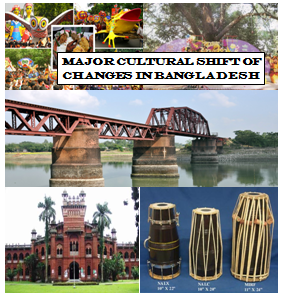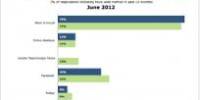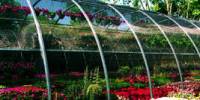Introduction
We are living in the modern state of Bangladesh that is now developing fast. Can you think of what the states of the undivided Bengal society? Would have been five hundred years ago! It is for sure that the social and cultural situation of Bengal in the Mughal period was somewhat different. Then British ruler came in Bengal. In British period Bengal was not separated. In Mughal period Bengal was not an independent and separate country too. Rather the region became a province under Delhi. In the Mughal period direct communication with North India was established. Also relations grew with middle and western Asia and outside India. As a result, the people of Bengal came into direct contact with thoughts and ideas, and behaviors of people of different countries. These had profound impact on different aspects in their lives, including their dressing pattern and food habit, education, religion, art and architecture among others.
Culture in Mughal Bengal
Babur was the founder of the Mughal Empire in undivided Bengal. During his time Bangla was not conquered. The Mughals always looked after the welfare of the subjects. The provincial administrators also shared the similar attitude. That is why peace and happiness prevailed at that time. This resulted in the Development in every field of education, culture and economy. The influence of the Mughals could be observed in the daily life of the people.
Dress
The dress and attire of the rich Hindus and the Zamindars began to change remarkably. They began to like the Mughal dress. Ornamented and pearl-studded glittering, dress, ‘salwar’ and ‘kamiz’ adorned the Hindus and the Muslims alike. In the Mughal Age, the rich and middle class women wore attractive dresses. They used to go out sometimes in Palaanquins. The condition of the villagers was not very good. They wore normal dresses and wooden sandals.
Food
Taste in food items changed. ‘Kabab’ ‘Rezala’, ‘Korma’ and other Mughal foods took their places beside the usual fish, rice and vegetables of the Bengalis.
Language
Although Persian was the dominant and “official” language of the empire, the language of the elite later evolved into a form of Hindustani today known as Urdu. Highly Persianized and also influenced by Arabic and Turkic, the language was written in a type of Perso-Arabic script known as Nastaliq, and with literary conventions and specialized vocabulary being retained from Persian, Arabic and Turkic; the new dialect was eventually given its own name of Urdu. Compared with Hindi, the Urdu language draws more vocabulary from Persian and Arabic (via Persian) and (to a much lesser degree) from Turkic languages where Hindi draws vocabulary from Sanskrit more heavily. Modern Hindi, which uses Sanskrit-based vocabulary along with Urdu loan words from Persian and Arabic, is mutually intelligible with Urdu.
Education and Literature
In the Mughal Age too, like the Age of the Sultans, there was a remarkable Development in education and literature. The employees recruited in the period were highly educated. They had great passion for learning. People of different professions like poets, teachers, doctors, etc. came with them. Consequently, their influence and endeavours greatly helped the advancement of education in Bengal. The Revenue Minister Raja Todarmal of Emperor Akbar introduced.
Persian language in government offices. Akbar helped a lot for the spread of education. For this reason the language and literature developed considerably in Bengal during the Mughal period.
Both the Hindus and Muslims learnt Persian to get government jobs. These Persian knowing officials were called ‘Munshis’. The books of the famous Persian poet Sheikh Saadi were very popular in this country at that time. The Nawabs and Subadars like Kasim Khan, Shah Shuja, Mir Jumla, Shayesta Khan and Murshid Kuli Khan worked a lot to develop the Persian language.
The influence of the Persian language on Bengali literature during the Mughal period can very well be observed. Persian is an affluent language. When the influence of a rich language falls on another language, the grandeur of the latter is enhanced. The same happened in the case of the Bengali language too. The Bengali language began to brighten in following the subject and style of the Persian language. Gradually the use of Persian words in Bangla began to increase. The Bengali Muslims began to introduce ideas and thoughts of Persian literature in their poems. Gazals and Sufi literature began to be evolved bearing likeness to Persian literature. The Hindu poets were inspired by the Sanskrit literature instead of Persian. Nevertheless, many of them could not avoid the Persian influence. The Vaishmava Padabali was composed following the Persian style. The influence of the Persian literature can be observed in the writing of the authors
like Bharata Chandra Raigunakar, etc. The Baul songs developed in Bengal during the Mughal rule. The poets at that time composed mourning songs of the Muharram also.
Religion
In the Mughal Age all people could follow their respective religions independently. The concept of Islam in the worship of Allah, equality and brotherhood greatly influenced the people of the country. There was a reaction among the Hindus for this. Some changes in the Hindu society followed consequently. The influence of ‘Vaishnava’ Movement of Sree Chaitnya was reflected in the social and religious life of the Hindus from the Age of the Sultans. This increased further in the Mughal Age. The common people began to accept the cult of devotion and spirit of equality. The orthodox Brahmins were deeply hurt at this.
The common Hindus opposed the religion of the orthodox Hindus and gave their attention to the worship of Mansha, Chandi etc. A mixed variety of Sufism emerged out of combination of the doctorine of Bhakti of Bengal with the Sufism of Persia during the Mughal period. In the way, Faqiri, Darves.hi, Baul and other mystic doctorines originated.
Architecture and Painting
Many beautiful buildings were built all over India during the Age of the Mughals. From Delhi and Agra, almost everywhere, there are specimens of Mughal architecture. Not only the Emperors but also the Mughal Subadars and high officers encouraged architecture greatly. That is why architecture flourished profusely during the Mughal period.
The Muslim architecture differed from the Hindu architecture. Generally speaking, Muslim architecture implies mosques, Idgahs, forts, mausoleums, monumenst etc. The design and beauty of the architecture of the Mughal Age differed from that of the other ages. The Mughal rulers did not like the architecture of the Sultani period in Bengal. The domes of the mosques of the Mughal period were matched. The surface of the domes were decorated with mosaic. The sides of the arches were decorated with floral designs. The pinnacles of the domes were long and pointed. The walls of the mosques were ornamented with floral designs. The size and shape of the buildings in Mughal period were big and massive. Some big ‘darawjas’ (doors) were built in Bengal during the Mughal Age. Also some buildings called ‘katra’ were built in the Mughal Age. These were guest houses. A ‘katra’, a tall minaret and a mosque were built in old Maldah during the time of Emperor Akbar. Many important buildings in the Mughal age were built in Dhaka. Subadar Islam Khan established the capital in Dhaka during the period of Emperor Jahangir. Mughal architecture started to develop in Dhaka from that time.
Subadar Shahjada Azam built some buildings in Dhaka. He built a huge ‘katra’ on the bank of the river Buriganga. The ‘Shahi Masjid’ in Lalbagh was built in his time. He started constructing the
Lalbagh Fort. Subadar Shayesta Khan took steps to complete it. But he could not be complete it. As a result, the construction of the Lalbagh Fort remained incomplete. This fort is the greatest example of Mughal architecture in Bengal. The mausoleum of the daughter of Shayesta Khan, Paribibi, is inside the fort. It is an attractive specimen of the Mughal architecture. The grave lies in the centre of the mausoleum and was made of marble stone. The floral designs are found on this grave. Apart from this, another structure called ‘Choto Katra’ was built in the time of Shayesta Khan. The name of Shayesta Khan is associated with the mosque of Chowkbazaar, the mosque on the bank of the River Buriganga and the ‘Saat Gombuz Mosque’.
Many buildings were also built during the period of the Nawabs in Bengal. The Zinjira Palace is their achievement. During the time of Murshid Kuli Khan the capital was transferred from Dhaka to Murshidabad. Many buildings were built there during that time. Murshid Kuli Khan built a katra and a mosque. A Palace named ‘Chehel Setun’ was built during his period. It was a huge ‘Darbar’ (assembly) building. Apart from these establishments, many ‘Eidgahs’, ‘Hammam Khana’, ‘Chillakhana’ and bridges were made during the Mughal period.
Culture in British period
Impact of British rule in India had been widespread throughout the country and affected the cultural, technological, religious, social, political and economic state of India. India had tenaciously tolerated the British rule for 200 prolonged years, with their everlasting impression been forever etched upon the succeeding Indian citizens. Impact of British rule in India, in this context, is one that had perhaps emerged forth right from the 16th century, when British missionaries had sailed to eastern soil to spread Christianity, much before the East India Company. There always exists a bright side to every dark silhouette; hence, impact of British rule upon India and Indians both constitutes superior and appalling elements, still in use in present times.
Foods
The period of the British rule in India and the love affair of the English with Indian food. This generally was hardly a glorified period in Indian history, but the British loved the general elaborate way of eating and adapted several of the food choices to their taste and developed the “curry” as a simple spice to help them cook Indian spice. This period resulted in the emergence of the Anglo-Indian cuisine and the emergence of certain “Raj” traditions like that of “high-tea” an elaborate late afternoon meal served with tea.
Religious
Main religions were Hinduism, Islam, Christian. But impact of British rule in India already had begun to do its work, with the very first Christian missionaries arriving to India, with the intention to turn a majority of population into Christians. They tried to cast Christianity in the light of a better religion and with economic inducements convinced the poor Indians into Christianity. British established the Christian missionary School to increase the Christianity in India.
The very foremost impact of British rule on India was the religious impact, as was established by the missionaries and their establishment of churches in every possible corner of the country. In this regard, the port cities like Kolkata, Mumbai and Chennai gained enough importance, due to their accessibility for navigational purposes.
Language
English was made the official language and several traditional Hindu customs were outlawed. Due to a bloody Indian rebellion in 1857, political power was transferred from the East India Company directly to the British Crown and the company dissolved. But people of British Bengal talked in Bangla and other local languages.
Socio-Cultural
The socio-cultural impact of British rule upon India was also another intense impression that had lasted throughout their rule, never for once losing their significant status. From every field of living, be it in education, art, architecture, painting, literature, poetry, drama, novels or even Indian religion and philosophy, the whole Indian set-up had suffered a gradual change.
Arts
Sculpture during early British rule was perhaps the most telling and excellent work of art that attracted numerous Indians and English alike. Church and finery works were primarily looked after, including perfect carvings of funeral epitaphs. Just like in other spheres, English sculptors also arrived in India in search of regal sponsorship and make their talent known to people on the other side of the globe. Benevolent British officers inaugurated a passionate theme of work, at times even dedicated to Indian men. War was also a common theme, which made way for these sculptors to render masterpiece work.
Natural history and art during British rule in India was momentous for its scholarly attempts by Englishmen to educate Indians in science, plant and animal life. Art had developed through such attempts, like painting by noted English people, resolved to make an educative endeavour in
India. Dissertation papers had come up from British scholars, alongside naturalistic paintings and further enhancement of flora and fauna.
Painting
Painting during early British rule in India was the result of an umpteen number of Englishmen coming to India in search proper ground to paint, perfect Oriental surroundings and royal sponsorship. These painters were to become famous during their lifetime, with a wide Indian acceptance. Initial works were begun with engravings, later to be substituted with oil paintings, especially portraits. Painters and their prized collection of paintings during early British rule in India was something that Indians during that time could feel proud of. The times were still untouched by the malicious motives of the East India Company or even later strife issues. As such, Indians and Englishmen mingled to give life to brilliant paintings, both indoors and outdoors, evident from their delicate brush strokes.
Architecture
Architecture during early British rule in India comprised colossal stone and wood structures, erected during the 17th century. In the emerging stages, British viceroy-generals like Robert Clive managed huge efforts to build such architectural wonders in the essential port cities of India. Early British architectural design composed of charts and outlined plans already erected successfully back in England. This period witnessed the shipping of skilled British architects and young men, equipped with clever motives to make Indian artistic design much like western modes. Indian educated class or the comparatively poorer class did not possess the amount of talent that their English masters were looking for. As such, architectures were planned by the already utilised British structural wonders.
Main festivals
Certain festivals in India are celebrated by multiple religions. Notable examples include Diwali, which is celebrated by Hindus, Sikhs and Jains, and Buddh Purnima, celebrated by Buddhists and Hindus. Islamic festivals, such Eid ul-Fitr, Eid al-Adha and Ramadhan, are celebrated by Muslims across India.
Theatre
Theater in India under British rule gained a global contour. It is during this time theater in India came into a direct contact with the western theater. It is during this 200 years of British rule Indian drama became lot more contemporary and naturalistic. Gone are the days of eposes, epics and “Loknatya” – theater in India under British rule for the very first time geared up fully towards a systematic and natural presentation. India, as a colony of the European empire used theater to illustrate the likings, dislikings of the British raj. The stylistic approach of theater in India under British rule changed quite drastically and the presentation started focusing mainly on the day to day life and common people.
Culture in Present Bangladesh
Music, dance, drama and film
The music and dance styles of Bangladesh may be divided into three categories, classical, folk and modern. The classical style has been influenced by other prevalent classical forms of music and dances of the Indian subcontinent, and accordingly show some influences dance forms like Bharata Natyam and Kuchipudi. The folk and tribal music and dance forms of Bangladesh are of indigenous origin and rooted to the soil of Bangladesh. Several dancing styles in vogue in the north-eastern part of the Indian subcontinent, like Monipuri and Santal dances, are also practiced in Bangladesh, but Bangladesh has developed its own distinct dancing styles. Bangladesh has a rich tradition of folk songs, with lyrics rooted into vibrant tradition and spirituality, mysticism and devotion. Such folk songs also revolve round several other themes, including love themes. Most prevalent of folk songs and music traditions include Bhatiali, Baul, Marfati, Murshidi and Bhawaiya. Lyricists like Lalon Shah, Hason Raja, Kangal Harinath, Romesh Shill, Abbas Uddin and many unknown anonymous lyrists have enriched the tradition of folk songs of Bangladesh. In relatively modern context, Rabindra Sangeet and Nazrul geeti form precious cultural heritage of Bangladesh. In recent time, western influences have given rise to several quality rock bands, particularly in urban centers like Dhaka. Several musical instruments, some of them of indigenous origin, are used in Bangladesh, and major musical instruments used are bamboo flute (banshi), drums (dhol), a single stringed instrument named ektara, a four stringed instrument called dotara, a pair of metal bawls used for rhythm effect called mandira. Currently, several musical instruments of western origin like guitar, drums, and saxophone are also used, sometimes alongside the traditional instruments.
Languages
Although there are 38 different languages of Bangladesh, Bengali is by far the most widely spoken language in the country – an estimated 98% of the population can speak it, and it enjoys the status of official language and the lingua franca of the nation. Arabic text is widely used in education. English is also widely used, especially in urban areas.
Festivals and celebrations
Festivals and celebrations are integral part of the culture of Bangladesh. Prominent and widely celebrated festivals are Pohela Baishakh, Independence day, National Mourning Day, Eid-ul-Fitr, Eid-ul-Azha, Muharram, Durga puja, and Language Movement Day.
Weddings
A traditional wedding is arranged by Ghotoks (matchmakers), who are typically friends or relatives of the couple. The matchmakers facilitate the introduction, and also help agree the amount of any settlement. Bengali weddings are traditionally in five parts: first it is the bride and groom’s Mehendi Shondha,the bride’s Gaye Holud, the groom’s Gaye Holud, the Beeya and the Bou Bhaat. These often take place on separate days. The first event in a wedding is an informal one: the groom presents the bride with a ring marking the “engagement” which is gaining popularity. For the mehendi shondha the bride’s side apply henna to each other as well as the bride For the bride’s Gaye Holud, the groom’s family – except the groom himself – go in procession to the bride’s home.Bride’s friends and family apply turmeric paste to her body as a part of Gaye Hoof bride, and they are traditionally all in matching clothes, mostly orange in colour. The bride is seated on a dais, and the henna is used to decorate the bride’s hands and feet with elaborate abstract designs. The sweets are then fed to the bride by all involved, piece by piece. The actual wedding ceremony “Biye” follows the Gaye Holud ceremonies. The wedding ceremony is arranged by the bride’s family. On the day, the younger members of the bride’s family barricade the entrance to the venue, and demand a sort of admission charge from the groom in return for allowing him to enter. The bride and groom are seated separately, and a Kazi (authorized person by the govt. to perform the wedding), accompanied by the parents and a Wakil (witness) from each side formally asks the bride for her consent to the union, and then the groom for his. The bride’s side of the family tries to play some kind of practical joke on the groom such as stealing the groom’s shoe. The reception, also known as Bou-Bhaat (reception), is a party given by the groom’s family in return for the wedding party. It is typically a much more relaxed affair, with only the second-best wedding outfit being worn.
Games and Sports
Football, cricket and kabaddi. Kabaddi is the national sport of Bangladesh. Cricket is a game which has a massive and passionate following in Bangladesh. Bangladesh has joined the elite group of countries eligible to play Test cricket since 2000. The Bangladesh national cricket team goes by the nickname of the Tigers—after the Royal Bengal Tiger. The people of Bangladesh enjoy watching live sports. Whenever there is a cricket or football match between popular local teams or international teams in any local stadium significant number of spectators gather to watch the match live. The people also celebrate major victories of the national team with a great enthusiasm for the live game. Victory processions are the most common element in such celebrations. A former prime minister even made an appearance after an international one day cricket match in which Bangladesh beat Australia, she came to congratulate the victory. Also in late 2006/early 2007, football legend Zinedine Zidane paid a visit to local teams and various events thanks to the invite of Nobel Peace Prize winner Dr. Muhammad Yunus.
Religion in Bangladesh
Bangladesh is ethnically homogeneous, with Bengalis comprising 98% of the population. The majority of Bangladeshis (about 90%) are Muslims, and a small number of Hindus, Christians and Buddhists are also in the country. But due to immense cultural diversity, multiple dialects, hybridization of social traits and norms as well as cultural upbringing, Bangladeshis cannot be stereotyped very easily, except for the only fact that they are very resilient in nature. People of different religions perform their religious rituals with festivity in Bangladesh. The Government has declared National Holidays on all important religious festivals of the four major religions. Durga Puja, Christmas and Buddha Purnima are celebrated with enthusiasm in Bangladesh. All of these form an integral part of the cultural heritage of Bangladesh. See also *Islam in Bangladesh *Hinduism in Bangladesh *Christianity in Bangladesh *Buddhism in Bangladesh
Food
Panta Ilish – a traditional platter of Panta bhat with fried Hilsa slice, supplemented with dried fish (Shutki), pickles (Achar), dal, green chillies and onion – is a popular serving for the Pohela Boishakh festival.
Bangladesh is famous for its distinctive culinary tradition, and delicious food, snacks and savories. Boiled rice constitutes the staple food, and is served with a variety of vegetables, fried as well as curries, thick lentil soups, and fish and meat preparations of mutton and chicken, and more rarely pork and beef by certain groups. Sweetmeats of Bangladesh are mostly milk based, and consist of several delights including Roshgulla, Sandesh, Rasamalai, Gulap Jamun, Kalo Jamun, Chom Chom. Several other sweet preparations are also available. Bengali cuisine is rich and varied with the use of many specialized spices and flavours. Fish is the dominant source of protein, cultivated in ponds and fished with nets in the fresh-water rivers of the Ganges delta. More than forty types of mostly freshwater fish are common, including carp varieties like rui (rohu), katla, magur (catfish), chingŗi (prawn or shrimp), as well as shuţki (dried sea fish). Salt water fish (not sea fish though) Ilish (hilsa ilisha) is very popular among Bengalis, can be called an icon of Bengali cuisine.
Dress
Nation dresses of Bangladesh are for men Panjabi and Pajamas and women for sharee. Bangladeshi people have unique dress preferences. Bangladeshi men wear Kurta on religious and cultural occasions, lungi as casual wear and shirt-pant on formal occasions. Salwar Kameez and Sharee are the main dresses of Bangladeshi women. Weaving the fabric for these dresses is a traditional art in Bangladesh.
Conclusion
In conclusion we can say that there many changes occur in different part of culture in Bengal from Mughal Bengal to today’s culture in Bangladesh. Like official language was Urdu in Mughal period, in British period it was English, now official language is Bangla. Besides foods items was different in three periods such as in Mughal foods were ‘Kabab’ ‘Rezala’, ‘Korma’ and other Mughal foods took their places beside the usual fish, rice and vegetables of the Bengalis, The period of the British rule in India and the love affair of the English with Indian food and today rice, fish, meat, vegetable, and other delicious foods like fast food, cakes etc. In addition, dresses were different in three periods like in Mughal period people wore wooden sandals but it does not put on it. Moreover, we notice the differentiation in different parts of culture like games and sports, Music, dance, drama and film , Festivals and celebrations, marriage ceremony, Architecture etc in Bengal from Mughal periods to present culture.
















